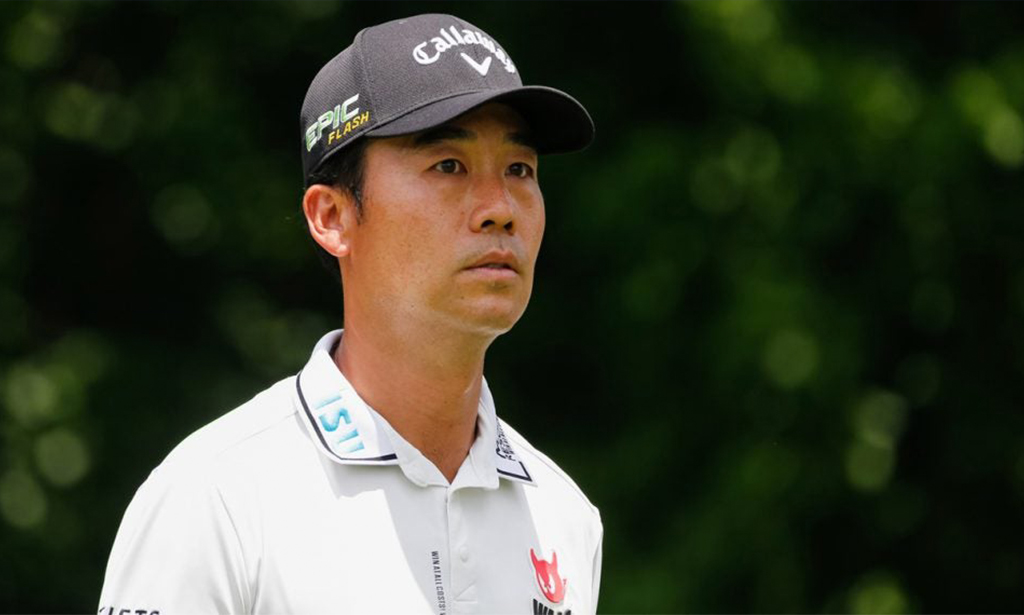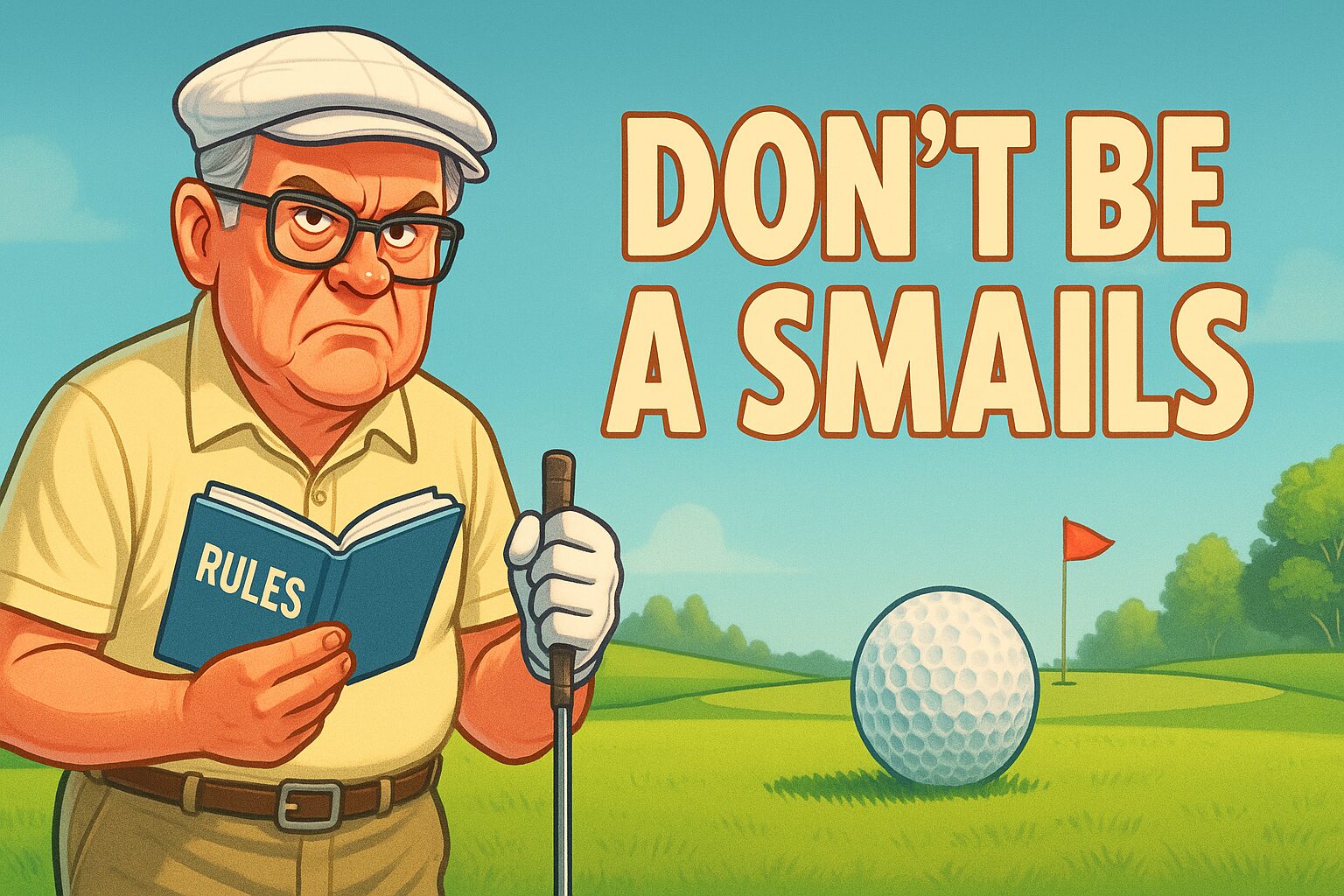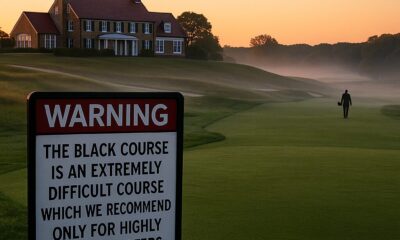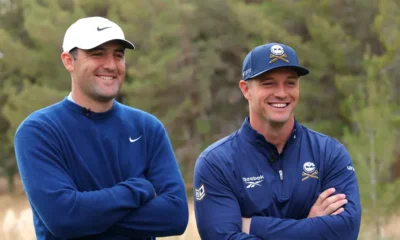Blog
A PGA Tour wedding, a football-TIGER crossover & Golf Twitter Beef

Hello friends! It’s time for another edition of the Weekend Report. I’m feeling really good this week because I’m officially on the way to becoming a Football Gal™️. I grew up “watching” the Patriots and Boston College football, but never really paid attention. Last week, I made it my goal to finally start to understand the game, and to my pleasant surprise, there has been quite some overlap between football and golf. Honestly, the whole thing reminds me of those Disney Channel crossover episodes I obsessed over as a kid! So, let’s get right into it.
Georgia golf alums celebrate the National Championship
Dawgs on top! pic.twitter.com/BNnKalnSKo— Kevin Kisner (@K_Kisner) January 11, 2022
When I think of college golf powerhouses, I think of the recent NCAA Championship winners: Stanford, Oklahoma State, etc. It’s not until photos like these appear on my social media feed that I remember the absolute DEPTH of the Georgia Bulldogs’ PGA Tour roster.
We’ve got the second and third place Sony Open finishers in this very photo, as well as Hudson Swafford, Keith Mitchell, Brian Harman and Harris English. Honorable mention to all of them for committing to golf’s official off-course uniform: khaki shorts and sneakers.
A PGA Tour wedding
Keith Mitchell got two birds with one stone on his trip to Hawaii. He got married AND played in the Sony Open. Keith married Claire Watson on the beach in Hawaii, and these are the only photos I’ve come across from the event. Between his T-7 finish at the Sony, Georgia winning the national title, and marrying the love of his life, we’re guessing it was a good week to be Keith Mitchell. Congrats to the happy couple!

Golf Twitter Drama!
A LOT happened on Twitter this week, and I’m breaking the main event into three acts to help you follow along. (Side note: if you are not on Twitter, you absolutely need to be. It’s where personalities shine, jokes are made and drama ensues.)
I. Grayson Murray and Kevin Na go at it
Kevin Na’s pace on the greens has been a point of discussion in the past, but it came up again after this photo of his playing partner Talor Gooch waiting on him at the Sony Open starting making the rounds on Twitter.
Talor Gooch might have a front row seat for a sub-60 round, but he’s not thrilled by the time it’s taking Na to putt. pic.twitter.com/9lcvHHYN0O— Barry W (@sacoomba) January 14, 2022
Next up, Grayson Murray Tweeted about it. And Na didn’t hold back in his reply.
Kevin Na taking 3 minutes to putt them. does get old. https://t.co/kzcJ8GtQjr— Grayson Murray (@GraysonMurray) January 14, 2022
II. The conversation continues, others get involved, Murray doubles down
The beautiful (or horrible) thing about Twitter is that anyone can chime into a conversation at just about any time. Take Ben An, for instance.
Somebody please call an ambulance for grayson here ??— Byeong Hun An (@ByeongHunAn) January 15, 2022
And then Colt Knost.
Dude…..what are you doing???? Just stop— Colt Knost (@ColtKnost) January 16, 2022
You trying hard for that PIP money early in the season— Colt Knost (@ColtKnost) January 16, 2022
Yeah, but normally the people stirring the pot are in the same kitchen as the others….?♂️— Colt Knost (@ColtKnost) January 16, 2022
haha sure he’s had a better career but doesn’t mean i’m afraid to take a jab at him for being slow.— Grayson Murray (@GraysonMurray) January 16, 2022
III. Na discusses it all on SiriusXM PGA Tour Radio
Kevin Na dunked on Grayson Murray after Murray chirped at him on Twitter last week. He told Colt and Drew that his tweet impressed fellow pros like superstar and Twitter master Brooks Koepka.@kevinna915 | @BKoepka | @ColtKnost | @thesleezyman | pic.twitter.com/g27fwVpvx4— SiriusXM PGA Tour Radio (@SiriusXMPGATOUR) January 17, 2022
Here’s what Na had to say:
“I had an idea people were going to laugh, because when I tweeted it, my caddie Kenny Harms was texting me, I said, ‘Look at this idiot.’ I said, ‘Watch this,’ and I showed him, he was laughing pretty hard. It was amazing how many players and caddies came up to me and complimented me, not on my round, about my tweet. I’ve had some big boys telling me how good it was. Even Brooks messaged me. Brooks Koepka messaged me saying how good of a tweet that was.Somebody mentioned oh, is this [like] the duel you had with Bryson and Brooks? First of all, [Murray’s] not even on Tour. You have to be somebody to make this worthwhile or make money out of this match. I mean, I can barely create a buzz — barely. I’m not a major-winner. I’m just a maybe above-average player on Tour. And who’s this guy? Nobody cares. That’s the sad part.”
Yikes!
Did Deebo Samuel wear a Tiger Woods mock neck under his jersey on Sunday evening? An in-depth analysis:
The following post blew up on Twitter on Sunday evening when TWLegion grabbed a screenshot of what appeared to be a Tiger Woods mock neck under Deebo Samuel’s jersey.
?#NEW: Deebo Samuel wore red TW shirt under the jersey ? pic.twitter.com/urHaINEJLB— TWLEGION (@TWlegion) January 17, 2022
But truthfully, that grainy image wasn’t enough proof. I zoomed and zoomed on that photo and, as much as I wanted to see the TW logo, I just didn’t. I needed more proof. So I did what any social media manager would do on a Sunday night and looked on Getty Images. Still no luck. Most of Deebo’s photos from the game were face-on. But I wasn’t giving up. I took my talents to his tagged photos on Instagram. Enter River Cracraft, who I’d like to thank for tagging his teammate in the following photo. (Sidebar: It’s amazing how quickly one can go from ‘learning football’ to ‘introducing a football player named River Cracraft to an audience of golf fans.’)
Ah-ha! Finally, a clearer image. I took the liberty of zooming in here as well and went from being like, 10% convinced that it was a Tiger Woods mock neck to about 50% sure. (It’s not perfect, but hey, it’s something!)
I also learned that both Tiger and Deebo are signed with Excel Sports Management, so it wouldn’t be too much of a reach for the 49ers wide receiver to be sporting the shirt. Of course, I promise to update you all on this very pressing issue if any more information becomes available.
That’s all I’ve got for this week, folks. I’m looking forward to my sleep schedule improving at the Tour moves from Hawaii to California this week — hopefully setting the stage for more appropriately timed Twitter drama. Until next week!
This article originally appeared on Golf.com.
Blog
The Unofficial Rules of Golf: A Gentleman’s Guide to Not Being Judge Smails
The official rulebook is thicker than a dictionary and twice as boring. Let’s talk about the rules that really matter on the course: how to have fun, respect the game, and not be a stick-in-the-mud. Hint: It involves less plaid and more cosmic harmony.

You’ve seen him. I’ve seen him. The guy who quotes the USGA rulebook like it’s scripture. He’ll happily tell you your ball moved a quarter of an inch when you addressed it, costing you a penalty stroke. He’s got a plumb bob for a three-foot putt and the personality of a rake. He is, in spirit, Judge Smails. And let’s be honest, nobody wants to be Judge Smails.
The real game of golf, the one that keeps us coming back, isn’t played by those rules. It’s played by a higher law. An unwritten code of conduct that’s all about flow, friendship, and the pursuit of that one perfect shot. It’s a gentleman’s agreement with the universe.
So, let’s talk about the rules that actually matter.
1. The Cosmic Readjustment (aka The Mulligan). Your first tee shot is a mess. It goes sideways into the woods where the gophers play. The Smails of the world would tell you to take a penalty and hack it out. I say the universe is just getting warmed up. The “breakfast ball” isn’t cheating; it’s a course correction. It’s an agreement among friends that a round of golf shouldn’t be ruined before it even begins. Take another. The Dalai Lama would want you to.
2. The Art of Flow (aka Pace of Play). This isn’t about rushing. Rushing is a fool’s game. This is about flow. It’s about being ready to hit when it’s your turn. It’s about watching your friend’s shot so you can help them find it. It’s about moving with a purpose, not like you’re searching for your car keys in a dark parking lot. Don’t be the anchor that drags the whole group down. See the line, hit the ball, walk on. Nanananana.
3. The Circle of Friendship (aka Gimmes). Is the putt inside the leather? Good enough. Pick it up. Life is too short to watch your buddies sweat over an 18-inch putt for a double bogey. A gimme isn’t just a time-saver; it’s a gesture of goodwill. It says, “I trust you, you trust me, and neither of us needs the anxiety of missing this tiny putt.” It’s good for the karma, and even better for the pace of play.
4. The Final Verdict (aka The 19th Hole). The most important rule is this: no matter what happened out there, you shake hands on the 18th green and settle things over a cold drink at the 19th. The guy who shot an 82 and the guy who shot a 102 are equals in the clubhouse. The stories get better, the putts get longer, and the bad shots fade away. This is where the real game is won.
So, forget about the fine print. Focus on the feeling. Be a good playing partner, enjoy the walk, and don’t be a Smails. You’ll find your score starts to take care of itself.
Did this speak to your soul? Pass it along to your foursome to make sure everyone is on the same page. For more deep thoughts from the fairway, be sure to follow us on social media. It’s the right thing to do.
Blog
When Golf Gadgets Fail: Navigating Common Tech Mishaps on the Golf Course
A Look at What Happens When Modern Golf Gadgets Go Wrong

Imagine this: you’re on the golf course, teeing off on a beautiful, sunny day. With the help of your trusty golf gadget, you’re confident you’ll hit a birdie or even an eagle. But just when you’re about to swing, your gadget malfunctions. Suddenly, your perfect game is thrown into chaos. Welcome to the world of technology fails, where even the most advanced golf devices can sometimes let you down. In this article, we’ll explore some common tech fails and provide some tips on how to handle them.
When Golf Gadgets Let You Down
Modern golf devices, from smart clubs to digital scorecards to GPS-enabled watches, have revolutionized the game. They provide golfers with real-time data, helping them refine their swing, choose the right club, and navigate the course. But what happens when these devices fail?
Unreliable Data
One of the most common golf gadget fails is inaccurate or unreliable data. GPS devices might show the wrong distance to the pin, swing analyzers might give incorrect feedback, and digital scorecards might miscalculate your score. This can be frustrating, especially when you’re relying on these devices to improve your game.
Battery Drain
Another common issue is battery drain. Many golf gadgets require a significant amount of power, and if they’re not properly charged, they can die in the middle of a game. This leaves you without the data you need to make informed decisions on the course.
Technical Glitches and Malfunctions
Sometimes, golf devices just stop working. They might freeze, crash, or refuse to turn on. These technical glitches can be caused by software bugs, hardware issues, or even user error.
Preventing Golf Gadget Fails
While it’s impossible to prevent all golf gadget fails, there are steps you can take to minimize the risk.
Regular Updates
Keeping your devices updated can help prevent software-related issues. Regular updates often include bug fixes and improvements that can enhance the performance of your device.
Proper Charging
To avoid battery-related problems, make sure to fully charge your devices before hitting the course. Some devices also have power-saving modes that can help extend battery life.
Backup Plan
It’s always a good idea to have a backup plan in case your devices fail. This might mean carrying a traditional scorecard or having a basic understanding of how to calculate distances without a GPS.
When Gadgets Go Wrong: The Bottom Line
Golf gadgets are a fantastic tool for any golfer looking to improve their game. However, like all technology, they can sometimes fail. By understanding the common issues and how to prevent them, you can ensure you’re prepared for any tech-related hiccups on the course. After all, golf is about more than just the gadgets—it’s about the experience, the skill, and the love of the game.
Blog
Mastering the Art of Overcoming Choking under Pressure: Strategies for Peak Performance
Learn the skills needed to stay calm under pressure.

Imagine this: you’ve spent countless hours honing your skills, preparing for that big presentation, important meeting, or decisive sports match. But, when the big moment arrives, instead of performing at your best, your mind goes blank, your hands shake, and you flub it. The dreaded phenomenon of ‘choking under pressure’ can strike anyone, from the seasoned professional to the eager amateur. So, how do you overcome this common mental roadblock? In this article, we’ll explore effective strategies to help you conquer the fear of choking and elevate your performance under pressure.
Understanding Choking under Pressure
Before you can overcome choking, it’s crucial to understand what it is. Psychologists define choking as performing below your ability under pressure. This can be due to heightened anxiety, overthinking, or fear of failure. The irony is, the more you care about performing well, the more likely you are to choke.
Why Do We Choke?
Several factors contribute to choking under pressure. Here are a few:
-
- Fear of Negative Evaluation: The fear of being judged negatively by others can cause significant anxiety, leading to poor performance.
- High Stakes: When the stakes are high, and the outcome is important, the pressure can cause you to underperform.
- Overthinking: The tendency to scrutinize every detail in high-pressure situations can divert your focus from the task at hand.
Strategies to Overcome Choking
Now that we understand why we choke, let’s delve into strategies to prevent it:
- Practice Under Pressure: Simulate high-pressure situations during practice to acclimate yourself to the stress.
- Focus on the Process, Not the Outcome: Concentrating on the process helps keep your mind focused and prevents overthinking.
- Use Positive Affirmations: Positive self-talk can boost your confidence and reduce anxiety.
Case Studies: Athletes Overcoming Choking
Many successful athletes have overcome choking to deliver exceptional performances. Take Michael Jordan, for example. He often missed crucial shots early in his career but used these failures to fuel his determination and eventually became renowned for his clutch performances. Similarly, Serena Williams has bounced back from choking in several matches to claim victory, demonstrating her mental toughness.
Choking under pressure is a common phenomenon, but with the right strategies, it can be overcome. By understanding the causes of choking and implementing techniques like practicing under pressure, focusing on the process, and using positive affirmations, you can learn to perform at your best when it counts the most. Remember, it’s not about never feeling pressure; it’s about learning how to thrive within it.
As Michael Jordan said, “I’ve missed more than 9,000 shots in my career. I’ve lost almost 300 games. 26 times, I’ve been trusted to take the game-winning shot and missed. I’ve failed over and over and over again in my life. And that is why I succeed.” So, next time you face a high-pressure situation, think of it as an opportunity to grow, not a threat to be feared.
If you’ve enjoyed this article and want to learn more about mastering your mental game, subscribe to our newsletter for more tips and strategies. Or, if you’re ready to take your mental toughness to the next level, check out our other articles designed to help you conquer pressure and perform at your peak.
-

 Product Review6 years ago
Product Review6 years agoThe Perfect Practice Putting Mat Review by Jason Tenzer
-

 Blog4 years ago
Blog4 years agoLoophole Rule Offers PGA Tour Pros a Mulligan
-

 Blog4 years ago
Blog4 years ago2021 Buyer’s Guide: The Top 10 Value Golf Balls For Distance & Feel
-

 Blog5 years ago
Blog5 years agoGolf Marriage Counselor
-

 Product Review6 years ago
Product Review6 years agoTHE ADJUSTABLE IRONS: WALKING STICKS GOLF CLUBS
-

 Blog6 years ago
Blog6 years ago9 Biggest Chokes Of The Past Decade
-

 Blog4 years ago
Blog4 years agoWhat Your Golf Clubs Say About You
-

 Equipment6 years ago
Equipment6 years agoOHK Sports Interview by Jason Tenzer






























